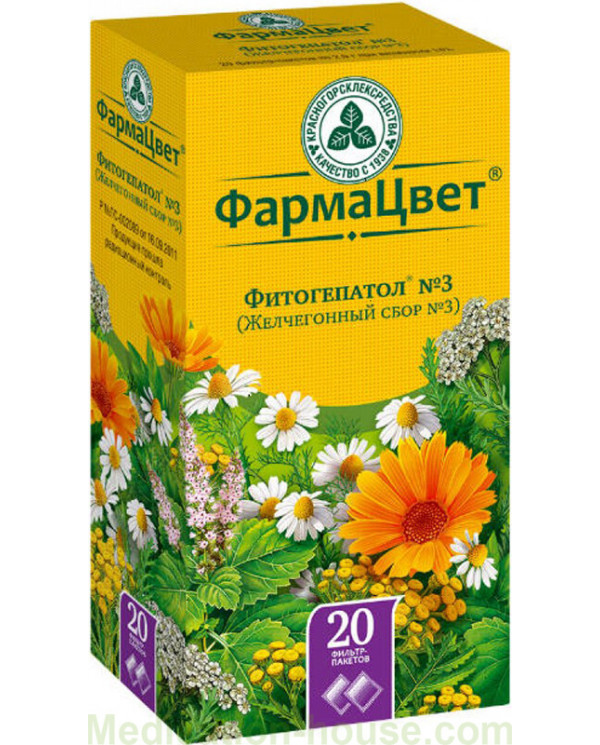Phytohepatol #3 instruction
You can buy Phytohepatol #3 on this page
Phytohepatol No. 3 - a choleretic drug of plant origin, has antispasmodic and anti-inflammatory effects.
Release form and composition
The dosage form of the drug is the collection of powder: an aromatic mixture of plant materials, consisting of heterogeneous particles of yellowish-brown color with intersperses of white, green, yellow, yellowish-orange and grayish-green; water extraction has a bitter taste and light viscosity (2 g each in filter bags, in a pack of cardboard 10 or 20 filter bags and phytohepatol No. 3 instructions for use).
The content of active plant components in 2 g of powder is:
chamomile pharmacy flowers: 23%;
peppermint leaves: 23%;
calendula officinalis flowers: 23%;
yarrow grass: 23%;
tansy ordinary flowers: 8%.
Pharmacological properties
Phytohepatol No. 3 (choleretic collection No. 3) is a natural herbal preparation containing a complex of medicinal herbs that provide a combination of three effects at once: choleretic, anti-inflammatory and antispasmodic. The therapeutic effect of the finished infusion is due to the properties of the plant components of the collection and their synergistic interaction.
Medicinal plants - components of Phytohepatol No. 3, composition and pharmacological properties:
pharmacy chamomile flowers (Matricaria chamomilla flower): contain flavonoids (apigenin), essential oils (matricin, matricarin, sesquiterpenes), carotenoids, salicylic acid, gums, bitterness, mucus, and other biologically active substances. They have anti-inflammatory, antispasmodic, moderate antimicrobial, diaphoretic, carminative, sedative and analgesic effects, inhibit fermentation in the intestine; increase the secretion of the digestive glands, with ulcers accelerate the regeneration of the epithelium;
peppermint leaves (Menthae piperitae folia): contain essential oils of menthol and its esters (isovalerianic and acetic acids) - up to 2%; cumulate copper, manganese, zinc, selenium. They have a calming, hypotensive, antispasmodic, antisclerotic, analgesic, anti-inflammatory, antiseptic, choleretic, diaphoretic, carminative, moderate laxative effect; eliminate nausea, help regulate the menstrual cycle, increase appetite;
Calendula officinalis flower (Calendula officinalis flower): contains resins, mucus, flavonoids, carotenoids, bitterness (calendale), malic and salicylic acid, saponin, triterpene glycosides, phytoncides; cumulate copper, molybdenum, zinc, selenium. They have a pronounced anti-inflammatory, bactericidal, antiviral, antimycotic, wound healing, antispasmodic effect; improve regenerative processes; stimulate the secretory activity of the digestive system; stimulate bile formation / bile secretion; have antiarrhythmic (reduce heart rate) and sedative effect. They have oncoprotective activity, proven high antiviral activity against influenza virus (type A and A2), in vivo demonstrate the ability to suppress herpes simplex viruses;
yarrow grass (Achillea millefolium herba): contains essential oils (borneol, azulenes, pinene, thujone, camphor, cineole), organic acids, flavonoids, tannins. They have hemostatic, anti-inflammatory, anti-allergic, bactericidal, wound healing, antihypertensive effects; reduce heart rate; relieve spasms of the bile ducts, intestines, stomach, urinary tract; tone the muscles of the uterus. Due to the bitter taste, excretion of the salivary glands is stimulated, bile secretion and secretion of gastric juice are enhanced; reduce flatulence;
tansy ordinary flowers (Tanacetum vulgare flower): contain essential oils (camphor, ketone, alpha and beta thujones, borneol, pinene), which are toxic; flavonoid compounds (derivatives of acacetin, luteolin, quercetin, apigenin), tannins, organic acids, ascorbic acid, alkaloids and bitterness, carotenoids; cumulate molybdenum, zinc, selenium. They have antispasmodic, anti-inflammatory, choleretic, diuretic, uterotonic, moderate laxative effects, normalize the menstrual cycle; possess antimicrobial, anti-invasive, sedative, analgesic, wound healing, antipyretic, diaphoretic, insecticidal, strong antihypoxic effect; tone the muscles of the digestive tract, enhance its secretion, increase the amplitude of heart contractions and blood pressure.
Indications for use
The use of Phytohepatol No. 3 is indicated as part of the complex treatment of biliary dyskinesia, chronic non-calculous cholecystitis and chronic hepatitis.
Contraindications
Absolute:
calculous cholecystitis;
pregnancy period;
breast-feeding;
hypersensitivity to the components of Phytohepatol.
With caution, only as prescribed by the attending physician, you should use the collection infusion for the treatment of children under the age of 12 years.
Phytohepatol No. 3, instructions for use: method and dosage
Water extraction of Fitogepatol No. 3 is taken orally 0.5 hours before meals.
To prepare the infusion, it is necessary to place 2 filter bags (4 g) in an enameled or glass vessel and pour 100 ml of boiling water. Covering the vessel tightly with a lid, allow the contents to infuse for 1/4 h, periodically clicking on the packets with a spoon. Pressing and removing the bags tightly, add boiled water to the infusion to obtain a volume of 100 ml.
Ready infusion can be stored in a cool place for no more than two days. Before taking it should be shaken.
Recommended dosage: 100 ml of the finished infusion 3 times a day.
The duration of treatment is from 14 to 28 days.
Side effects
Against the background of the use of infusion from plants, the appearance of heartburn, the development of allergic reactions is possible.
Overdose
Symptoms of an overdose of Phytohepatol have not been established.
Special instructions
The use of choleretic infusion should begin after a preliminary consultation with the attending physician.
Influence on the ability to drive vehicles and complex mechanisms
The effect of Phytohepatol on the patient's ability to drive vehicles has not been established.
Pregnancy and lactation
The use of choleretic collection Phytohepatol No. 3 during pregnancy and lactation is contraindicated.
Use in childhood
Due to the lack of a sufficient number of clinical studies, without the supervision of a doctor, it is not recommended to use the drug for the treatment of children under the age of 12 years.
Drug interaction
Infusion of choleretic collection Phytohepatol No. 3 is indicated for use in combination with other drugs for the treatment of biliary tract diseases.
Terms and conditions of storage
Keep out of the reach of children.
Store in a place protected from moisture and light.
Shelf life is 2 years.
Reviews about Phytohepatol №3
All reviews about Phytohepatol No. 3 are positive. Along with efficiency, patients include soft action, natural composition, good tolerance, and accessibility to the advantages of a choleretic agent.
Terms of sell
You don't need a prescription to buy Phytohepatol #3.

